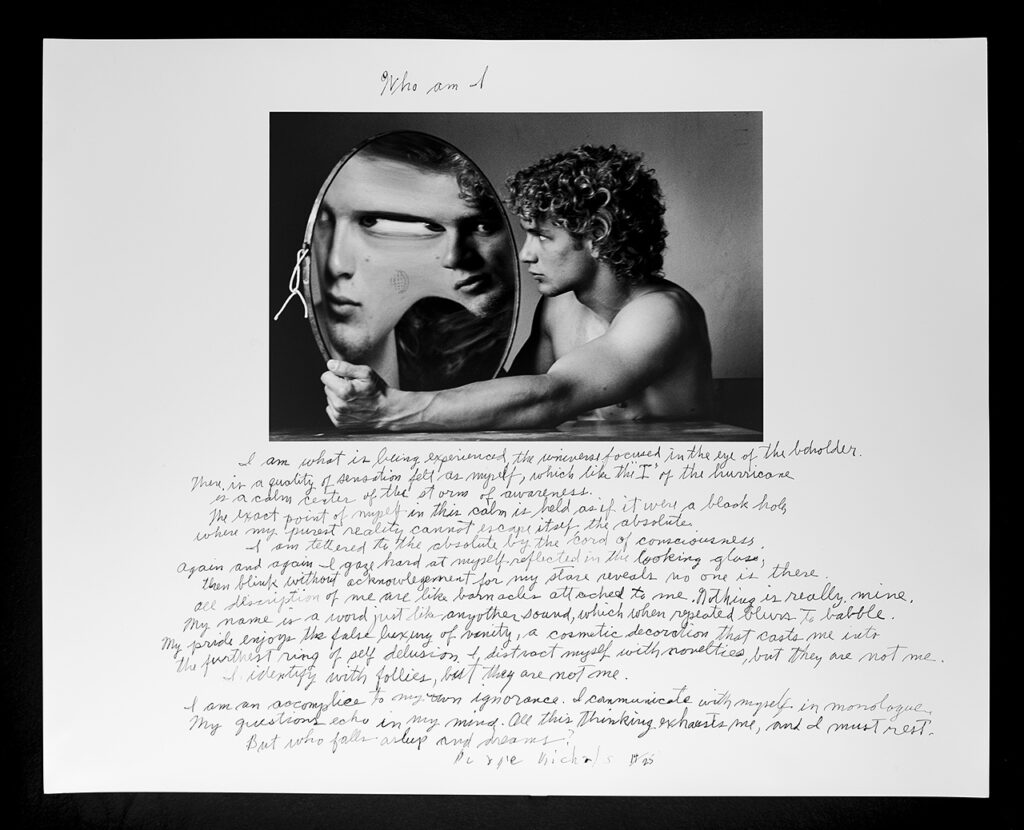“I think photographs should be provocative and not tell you what you already know. It takes no great powers or magic to reproduce somebody’s face in a photograph. The magic is in seeing people in new ways.” — Duane Michals

Duane Michals, Self Portrait as Unicorn, 2022 | Image courtesy of the artist, DC Moore Gallery and The Brooklyn Rail
Duane Michals (b. 1932, McKeesport, Pennsylvania) is an American photographer as well as one of the great photographic innovators of the last century, widely known for his work with series, multiple exposures and text. Michals makes innovative use of photograph sequences, recalling cinematic storytelling and depicting emotion and universal themes such as love, death and immortality. Incorporating text into his work, Michals’ handwritten text adds another dimension to the images’ meaning and gives voice to his singular musings, which are poetic, tragic and humorous, often all at once.

Duane Michals, Andy Warhol and his Mother Julia Warhola, 1958 | Image courtesy of the artist and Curatorial
In 1953, Michals received his BA from the University of Denver. In 1956, after two years in the Army, he worked as a graphic designer until his involvement with photography deepened in the late 1950s. In 1960, he began photographing for magazines Mademoiselle and Esquire, and became a prolific portraitist of artists such as Andy Warhol, René Magritte and Marcel Duchamp. In 1970, his first solo exhibition was held in the Museum of Modern Art, New York.

Duane Michals, Marcel Duchamp, 1964 | Image courtesy of the artist and Musée d’Art moderne de Paris
Over the past five decades, Michals’ work has been exhibited in the United States and abroad, including the Odakyu Museum, Tokyo (1999); the International Center of Photography, New York (2005); the Thessaloniki Museum of Photography, Greece (2008); the Scavi Scaligeri, Verona, Italy (2008); the Morgan Library and Museum, New York (2019). Due to his remarkable contributions to the artistic photography movement in the 1960s and the 1970s, Michals received a Gold Medal for photography from The National Arts Club in 1994; a Masters Series Award from The School of Visual Arts in 2000; and an honorary DFA from Montserrat College of Art in Beverly, MA in 2001.
Michals’ “prose portrait”
Expression is the key word in Michals’ body of work. He wrote or did whatever he needed to do to express an idea. “I really want to know what things feel like, not what they look like. I call myself expressionist, not a photographer or a writer.” Michals changed the very nature of what a photograph could be, inventing a way of expressing the idea by adding words to a photograph, telling little mini movies and stories with a photograph, and painting on a photograph. The subject of a photograph is liberated from being an exterior subject to an interior subject in his photographs.

Duane Michals, Self-Portrait with My Guardian, Angle, 1974 | Image courtesy of the artist, DC Moore Gallery and Moderna Museet
“Prose portrait” is a new concept invented by Michals, emphasizing the nature of who the subjects are or what they do in the photographs. For Michals, his prose portrait does not necessarily show the audience what someone looks like, and it is not a line-for-line reproduction of a face. “You can’t capture someone, per se. How could you? The subject probably doesn’t even know who he (or she) is. So, for me, a prose portrait is about a person, rather than of a person.” Sixty per cent of his work is photography and the rest is writing to tell you what we cannot see in the photographs. Michals’ writing grew out of his frustration with photography, responding to the limitations of the medium — the silence of the still image. The decisive moment is a very important category in photography. He did the moment before and the moment after that. “What I did was to stretch the moment, to give me more space. Rather than just depending on the one photograph, I had some room to develop an idea and to tell a story.”
It’s who I am
“I am also an empiricist, so I can only make work about what I have experienced.” Michals frequently photographed desire but reportage is not his interest, particularly the cliched images of homoeroticism. “I’ve always dealt with gay experiences. It’s who I am. I could tell you very clearly what it feels like to be an 86-year-old, bald, gay man but you have to bring insight. It’s not just anatomy.”

Duane Michals, Who Am I, 1994 | Image courtesy of the artist and Sunpride Foundation
In Michals’s photographic series “Things Are Queer” (1973), his subject has nothing to do explicitly with “homosexuality”. Art historian Jonathan Weinberg interprets his work that “the queer of Things Are Queer is not a matter of specific sexual identities but the world itself. The world is queer because it is known only through representations that are fragmentary and in themselves queer.” Michals’ body of work highlights how we compartmentalise things, normal/abnormal, gay/straight, decent/obscene.


